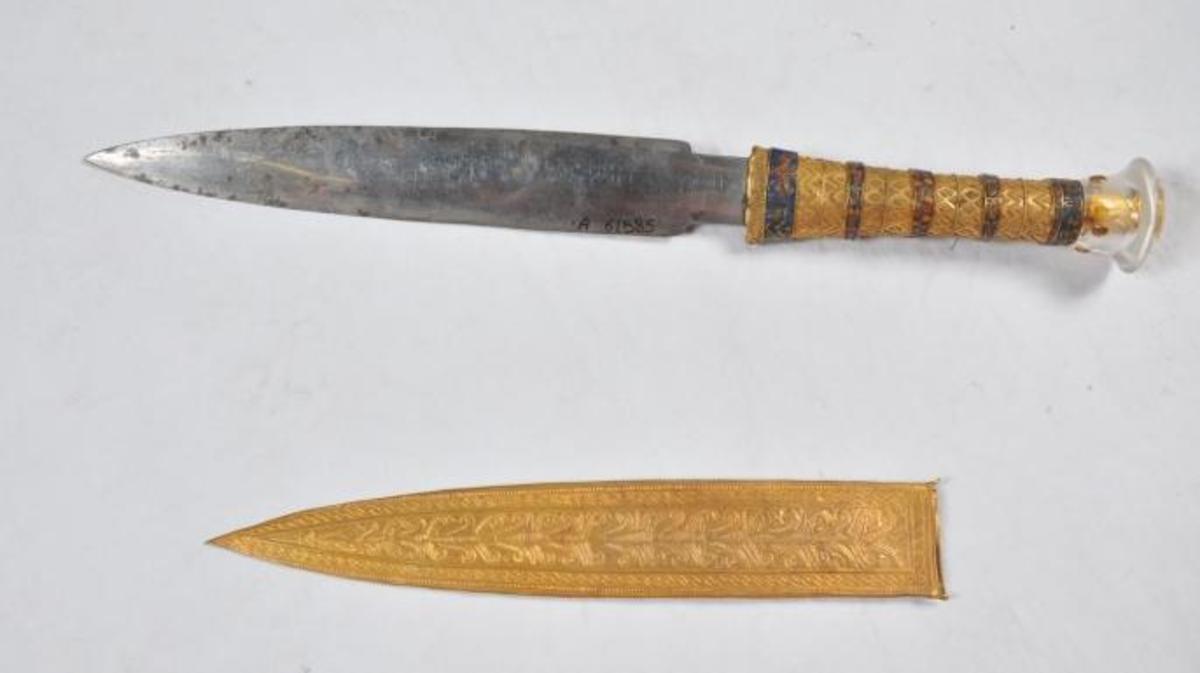At the heart of King Tutankhamun’s tomb lay a dagger whose blade gleamed with a pale, silvery shine. In February 1923, when Howard Carter first breached the pharaoh’s sealed burial chamber in the Valley of the Kings, he uncovered a blade that looked unlike any bronze or copper artifact in the suites of funerary treasure. Modern portable X-ray fluorescence tests carried out in 2016 revealed that the dagger’s metal contained approximately 10.8 percent nickel and 0.58 percent cobalt—far above any terrestrial source—confirming it was crafted from meteoritic iron. How did artisans in the late 14th century BCE recognize and shape such rare “sky metal” long before people mastered smelting?
Thousands of kilometers to the north, Inuit communities in Greenland developed a tradition of collecting and cold-working fragments of the Cape York meteorite long before the invention of magnetometers or spectrometers. These iron-rich masses, scattered across the tundra of northwestern Greenland, provided a rare source of workable metal in an otherwise metal-poor environment. During his Fifth Thule Expedition (1921–24), ethnographer Knud Rasmussen recorded how Inuit families passed down knowledge of iron-rich sites, returning over generations to retrieve small fragments for tools. By the early 19th century, European explorers—including Captain William Scoresby—noted the remarkable craftsmanship with which Inuit smiths hammered these meteorite pieces into uluit and harpoon tips, tools that proved exceptionally durable in Arctic hunting conditions.
Background & Context
Before about 1200 BCE, societies across the Near East and Mediterranean lacked furnaces hot enough to smelt terrestrial iron ore, making meteoritic iron the only available source of metallic iron. In Egyptian hieroglyphs of the early 19th Dynasty (c. 1295 BCE), one finds the term bjꜣ-n-pt, literally “iron of the sky,” used to describe such rare metal. Similarly, in Mesopotamia by the first millennium BCE, scribes wrote AN.BAR (often rendered “iron of heaven”) on clay tablets when listing offerings to temples and kings—though by that time AN.BAR may also have included some smelted iron alongside true meteoritic pieces. Even without fully understanding its extraterrestrial origin, ancient peoples recognized that this metal differed in weight, luster, and durability from any known ore.
Within the Arctic, Inuit communities near Cape York relied on ancient meteorite fragments as a rare source of workable iron. The Cape York meteorite, which fell thousands of years ago, shattered into several masses across northwestern Greenland. One of the largest fragments, later named Ahnighito, weighs over thirty metric tons and remains partially embedded in the ground. While its massive size made it difficult to use directly, smaller nearby fragments—such as Saviksoah and Tununrliq—were collected and cold-hammered by Inuit smiths into blades, harpoon tips, and carving tools. Knowledge of these iron-rich locations was preserved and passed down through oral tradition, allowing families to return to known sites when metal was needed.
Across continents and millennia, “iron from the sky” appears in royal tombs, ritual caches, and archaeological layers dating to before widespread iron smelting. From Bronze Age daggers of Anatolia to Shang dynasty axes in China, meteoritic iron carried both symbolic and practical importance. Yet how early smiths learned to hammer and modify a metal that cools slowly in space—and how cultures as far-flung as Egypt, Greenland, and China valued that metal above all others—remains one of archaeology’s most compelling mysteries.
Tutankhamun’s Cosmic Blade
When Howard Carter first lifted King Tutankhamun’s dagger from its golden sheath in February 1923, the blade shimmered with a sheen that resisted tarnish. Comelli et al. (2016) demonstrated that it contains roughly 10.8 wt percent nickel and 0.58 wt percent cobalt—hallmarks of a meteoritic origin. Without magnets or XRF devices, Egyptian metalworkers probably distinguished this iron by its unexpected weight, cool touch, and the ringing sound it produced when tapped with a bronze scraper. Pyramid Texts and later inscriptions use bjꜣ-n-pt to describe such metal, showing that by the early 18th Dynasty (c. 1300 BCE), “sky iron” held spiritual and ceremonial significance.
Scholars debate how a chunk of cosmic iron reached Tut’s craftsmen—some propose Nubian traders moved small meteorite fragments north along caravan routes, while others believe royal emissaries dispatched desert expeditions after observing meteors. By Tutankhamun’s reign (c. 1332–1323 BCE), obtaining iron from the sky was such a mark of prestige that the dagger was placed near the pharaoh’s chest to symbolize his passage to the afterlife. Yet no surviving record explains exactly how expeditions located or recognized these fragments amid the desert’s shifting sands, leaving a gap in our understanding of this ancient trade network.
Arctic Meteorite Iron Tools
Inuit communities near Cape York used ancient meteorite fragments as a rare source of iron long before the arrival of European traders. The Cape York meteorite, which fell millennia ago, broke into multiple masses, including Ahnighito, which weighs over thirty metric tons. While the largest pieces were mostly immobile, Inuit hunters collected smaller fragments from known locations and cold-hammered them using antler hammers and stone anvils. These iron tools, shaped into ulu blades and harpoon points, offered practical advantages over bone or stone, especially when cutting through thick hides and seal blubber. Archaeological findings confirm the remarkable skill with which these materials were worked. Though Inuit oral tradition preserved knowledge of where the iron could be found, there is no evidence that new meteorites were actively sought or imbued with cosmological meaning.
While some Ahnighito fragments weighed over a ton, smaller pieces—often under one kilogram—were prized by Inuit smiths. They used antler hammers and granite anvils to cold-forge these meteorite shards, flaking away brittle edges until shaping ulu knives and harpoon points. These tools enabled cleaner cuts through seal blubber and tougher hides, offering a distinct advantage in Arctic conditions. Knowledge of the iron’s location was preserved through oral tradition, allowing generations to return to these valuable sites.
Sky Iron Across Early Civilizations
Before smelting techniques appeared, scattered pieces of meteoritic iron were highly sought in Bronze Age cultures. In Anatolia, excavations at Alaca Höyük unearthed an iron dagger dating to around 2500 BCE; geochemical analysis confirmed it contains roughly 7–9 percent nickel, indicating a meteoritic source. Around 2300 BCE at Umm el-Marra in Syria, a small iron pendant likewise proved meteoritic when scientists detected similar nickel–cobalt ratios. By 1400 BCE, both Ugarit on Syria’s Mediterranean coast and the Shang dynasty in China produced axes or chisels from meteoritic iron, revealing that sky metal circulated from Anatolia as far as China during the Late Bronze Age.
In the Hittite capital Hattusa (c. 1500 BCE), archaeologists uncovered small corroded iron strips that X-ray fluorescence measurements in 2012 confirmed contained nickel levels typical of meteorites. Hittite cuneiform tablets refer to AN.BAR GE nepis (“black iron from heaven”), implying a ritual dimension to retrieving and working such metal. Further south, Mesopotamian scribes inscribed AN.BAR on tribute lists to royal palaces and temples, pairing sky iron with lapis lazuli and imported cedar—luxuries denoting high status. Yet no surviving text explains precise forging techniques: smiths had to avoid fracturing brittle meteoritic iron by controlling hammer blows or by very brief annealing—skills now inferred only from microstructural studies.
Craftsmanship and Cultural Beliefs
Shaping meteoritic iron tested ancient smiths’ ingenuity. Without bellows to reach the temperatures required for smelting, early craftsmen relied on cold forging: repeatedly hammering small iron fragments on stone anvils to shape them into tools or ornaments. In Egypt, metalworkers likely used bronze tools to chip or grind meteoritic iron into blades, including the dagger found in Tutankhamun’s tomb. Though no ancient text records the technique, modern analysis shows the blade was expertly crafted from a high-nickel iron consistent with a single meteoritic source.
Across cultures, sky iron carried meaning far beyond its utility. In southern Poland, a February 2025 study in the Journal of Archaeological Science: Reports confirmed that four Lusatian Culture ornaments—three bracelets and a pin—were made of ataxite-type meteoritic iron, prized for its rarity and celestial origin. In Namibia, the Nama people used fragments of the Gibeon meteorite to forge spear points and knives, while in Tibet, shamans fashioned meteoritic iron—called Thokcha—into ritual amulets and votive objects, believed to embody protective spiritual forces.
Mörigen Arrowhead and Polish Iron Age Finds
In August 2023, archaeologists discovered a Bronze Age arrowhead near Mörigen, Switzerland, whose composition (about 7.12–8.28 percent nickel, 0.85 percent cobalt) matched IAB-type ataxite meteorites from Estonia’s Kaalijarv fall. Initially, researchers had considered the nearby Twannberg meteorite, but its lower nickel content ruled it out; chemical composition pointed firmly to Kaalijarv. This arrowhead—now exhibited at the Bern Historical Museum through April 2025—may have served as a prestige weapon or ritual object, underscoring how early smiths recognized and transported sky metal across vast distances. Analytical techniques such as portable XRF, scanning electron microscopy (SEM/EDS), and X-ray microtomography confirmed ataxite-type metal, suggesting Early Iron Age artisans locally sourced and deliberately worked meteoritic fragments into ornamental objects. These findings expand the map of pre-Iron Age iron use, linking Central European communities to broader traditions of sky-metal collection.
For the last few years, archaeometallurgists have increasingly turned to high-resolution, non-destructive imaging methods—such as portable XRF and computed tomography—to reexamine Bronze Age and Early Iron Age artifacts in museum collections across Europe. In some cases, objects previously thought to be early smelted iron have revealed telltale nickel-rich compositions characteristic of meteoritic metal. This emerging wave of analysis is prompting calls for systematic testing of unexamined artifacts, including blades, pins, and ornaments. With each new identification, researchers deepen their understanding of how far meteoritic iron traveled and how interconnected early societies may have been in valuing and trading this rare cosmic material.
True pieces of… cosmic art?
Standing before Tutankhamun’s dagger in Cairo’s Egyptian Museum, one sees not only a perfectly preserved artifact but also a direct link to cosmic events that unfolded long before humans recorded history. Its polished surface, echoing distant stars, reminds us that late Bronze Age artisans possessed the insight to treat fallen meteorites as both divine and practical resources. Far to the north, Inuit ulu knives cold-forged from Cape York fragments exemplify another strand of this story—one where families braved Arctic storms to claim iron that rang like a call from the sky.
From Anatolian daggers at Alaca Höyük to Shang dynasty axes, from Mörigen’s Bronze Age arrowhead to Lusatian Culture bracelets, each object tells of a time when metallurgical innovation and spiritual reverence coalesced around iron born among the stars. Yet across continents and centuries, we still lack written records of the first smiths who learned to cold-hammer meteorites or the precise routes by which sky-metal traveled. Until the next meteorite fall—perhaps landing near desert sands or melting snowfields—we remain poised between wonder and inquiry, asking: Which unseen fragment of iron might next bridge Earth and sky?











